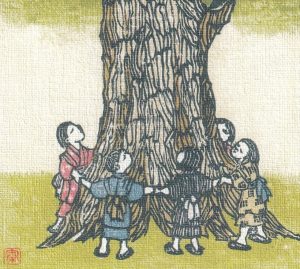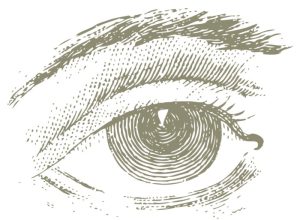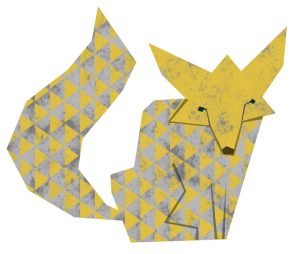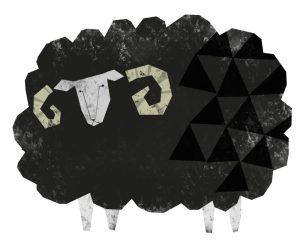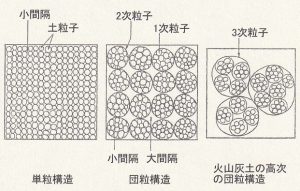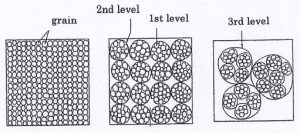
予め長編連載の全体像を把握するために Ⅰ
In Order to Help You to Grasp the Overall Picture of the Long-running Series in Advance Ⅰ
★Ⅰ.≪総括にかえて≫の核心部分
The main parts of “In Lieu of a General Summary”
Ⅱ.≪「菜園家族」未来社会構想と日本国憲法との内的連関≫
“The Interrelation between the ‘Garden Family’ Vision for a Future Society and
the Constitution of Japan”
Ⅲ.≪総目次一覧≫
“The Complete Table of Contents”
◆ こちらからダウンロードできます。
日本語原文(the original Japanese text)
「予め長編連載の全体像を把握するために」
Ⅰ.≪総括にかえて≫の核心部分
(PDF:718KB、A4用紙20枚分)
◆ Please download here.
Tentative English Translation(英語試訳)
“In Order to Help You to Grasp the Overall Picture of the Long-running Series in Advance”
Ⅰ. The main parts of “In Lieu of a General Summary”
(PDF:399KB, 23pages)
(Followed by tentative English translation)
Ⅰ.≪総括にかえて≫の核心部分(the original Japanese text)
長編連載「いのち輝く共生※1 の大地 ―私たちがめざす未来社会―」の総括にかえて
長編連載の終了にあたり、その総括にかえて、後述の「近代(資本主義の時代)を超克する高次国民運動への根源的転換に向けて」を8項目にわたって掲載します。
つまりそれは、―「地域」※2 と「労働」の私たち自身の足もとから築く“21世紀、高次国民運動”への根源的転換―をめざすものです。
これを骨子に、あまたの英知に学び、さらなる目標に向かって努めていきたいと思います。
長編連載の≪総括にかえて≫に先立ち、まずは長編連載そのものを振り返り、◆長編連載の核心的根幹◆を簡潔に確認することからはじめたいと思います。
ところで、かつての19世紀未来社会論には、当時の科学研究上の時代的制約から、当然のことながら、大自然界の生成・進化の「適応・調整」の原理(=「自己組織化」※3 )を、自然界と人間社会両者を貫く生成・進化の普遍的原理に止揚し、その普遍的原理を基軸に、未来社会を構想する発想は、残念ながらなかったといってもいい。
今日、「自己組織化」の理論は、とくに自然科学研究の分野においては広く定着しているにも関わらず、その原理を自然界と人間社会両者を貫く全一体的(ホリスティック)な普遍的原理に措定し、19世紀未来社会論を敢然と止揚し、21世紀未来社会論を理念および具体的方法論にわたって構想する例は、管見の限り見当たらない。
こうした今日の未来社会論の現状を根源的に是正すべく試みたのが、この 長編連載 「いのち輝く共生の大地 ―私たちがめざす未来社会―」の内実であり、21世紀“生命系の未来社会論”具現化の道としての「菜園家族」未来社会構想に込められた理念と具体的方法論なのである。
大自然界と人間社会両者の生成・進化を貫く「適応・調整」の普遍的原理(=「自己組織化」)、およびそこから自ずと導き出される「地域生態学」的方法論※4 を二つの大切な基軸にして、この長編連載「いのち輝く共生の大地 ―私たちがめざす未来社会―」は展開されている。
特に、大自然界の生成・進化の原理(=「自己組織化」)、および地域生態学的基軸方法論、これら二つの論点に刮目して、再度、本連載を読み通していただければ幸いである。
※1「共生」(symbiosis)とは、もともと生物学上の用語であるが、その肯定的側面の内実の萌芽は、やがて人間社会における未来への明るい可能性を秘めた十全な「共生」へと転化していくであろう。この長編連載では、こうした意味合いで、自然界における原初的「共生」の未来への可能性の確信のもとに、この用語を援用することにする。
それを可能にする要因として考えられるのは、本連載の本文第3章および第11章2節で取り上げた、ヒト特有の原初的「共感能力」(慈しむ心)との人類史上、長きにわたる葛藤によるものと見るべきであろう。
※2 「菜園家族」未来社会構想における「地域」の概念規定については、長編連載「いのち輝く共生の大地」の本文第5章2節で詳述。
※3 「自己組織化」については、生物に見られる自己組織化理論と生物複雑系科学の第一人者であるアメリカの研究者スチュアート・カウフマンの著作『自己組織化と進化の論理 ―宇宙を貫く複雑系の法則―』(米沢登美子 監訳、日本経済新聞社、1999年);原典 Kauffman,Stuart “AT HOME IN THE UNIVERSE:The Search for Laws of Self-Organization and Complexity”, Oxford University Press, Inc., 1995 を参照されたい。
※4 「地域生態学」的方法論については、長編連載「いのち輝く共生の大地」の本文第5章2節で詳述。
◆長編連載の核心的根幹◆
米中露「三超大国」を基軸に
先進資本主義諸国入り乱れての
醜い多元的覇権抗争の時代。
超大国、大国いずれの国においても
国民主権を僭称する
一握りの政治的権力者は
分断と対立と憎しみを煽り
民衆に
民衆同士の凄惨な殺し合いを強制する。
今や世界は生命を蔑ろにして恥じない
倫理敗北の時代に突入している。
今こそ
自然観と社会観の分離を排し
大自然界の生成・進化を貫く
「適応・調整」(=「自己組織化」)の原理を
両者統一の生成・進化の普遍的原理に止揚し
社会変革のすべての基礎におく。
根なし草同然の賃金労働者と
生産手段との「再結合」による
近代と前近代の「労」「農」人格一体融合の
抗市場免疫に優れた
新たな人間の社会的生存形態
「菜園家族」を基礎単位に構築される
21世紀の未来社会構想。
“生命系の未来社会論” 具現化の道としての
この「菜園家族」未来社会構想の根底には
人々の心に脈々と受け継がれてきた
大地への回帰と止揚(レボリューション)という
民衆の揺るぎない歴史思想の水脈が
深く静かに息づいている。
まさにこの民衆思想が
冷酷無惨なグローバル市場に対峙し
大地に根ざした
素朴で精神性豊かな生活世界への
新たな局面を切り拓く。
世界は変わる
人が大地に生きる限り。
人間復活の高次自然社会を展望するこの “生命系の未来社会論” の核心は、とどのつまり、21世紀の今日の現実から出発して、脱資本主義に至る長期にわたるプロセスのいわば中間項に、近代と前近代の「労」「農」人格一体融合の抗市場免疫に優れた社会的生存形態「菜園家族」を基調とするCFP複合社会※ の生成過程を必要不可欠の一時代として措定し、位置づけていることにある。
まさにこの点において、「菜園家族」未来社会構想は、19世紀以来、人類が連綿として探究し続けてきたこれまでの未来社会論に対して、あらためて再考を迫るものになるであろう。
まさしくそれは、19世紀マルクス未来社会論アウフヘーベンの肝心かなめの鍵であり、今日社会の閉塞・混迷自体をも打開する、希望と創意あふれる明日への道でもあるのです。
※ 資本主義セクターC(Capitalism)と、家族小経営セクターF(Family)と、公共的セクターP(Public)の3つのセクターから成る複合社会。
― 長編連載の≪総括にかえて≫ ―
近代(資本主義の時代)を超克する
高次国民運動への根源的転換に向けて
近代巨大建造物は
まさしく音を立て
今や腐蝕と崩落の目前にある。
欺瞞に充ち満ちた
「選挙」の卑小な枠組みに埋没し
権力の術中に陥ることなく
21世紀の新たな人間の社会的生存形態「菜園家族」を土台に
大地に根ざした、いのち輝く民衆主体の
高次国民運動への根源的大転換へ。
―― ≪総括にかえて≫ の 目 次 ――
(1)民衆の生活世界を自らの足元から築く
―腐り切ったわが国の「政治」を乗り越えて―
(2)21世紀こそ草の根の変革主体の構築を
―まことの民主主義の復権と「地域」と「労働」の再生―
「お任せ民主主義」を社会の根っこから問い直す
身近な語らいの場から、未来への瑞々しい構想力が漲(みなぎ)る
(3)労働組合運動の驚くべき衰退、そこから見えてくるもの
(4)21世紀の労働運動と私たち自身のライフスタイル ―「菜園家族」の新しい風を―
(5)「菜園家族」型ワークシェアリングと21世紀労働運動の革新
(6)多彩で自由な人間活動の「土づくり」
―次代への長期展望に立った
国民的運動への根源的大転換に向けて―
(7)「お任せ民主主義」を排し、何よりも自らの主体性の確立を
―そこにこそ人間としてまことの生きる喜びがある―
(8)身近な郷土の「点検・調査・立案」の連続らせん円環運動から
“21世紀の未来”が見えてくる
――― ◇ ◇ ―――
―メモランダム風に―
以下8項目
(1)民衆の生活世界を自らの足元から築く
―腐り切ったわが国の「政治」を乗り越えて―
21世紀における
資本主義超克の
人間復活のレボリューション。
週休(2+α)日制のワークシェアリング(但し1≦α≦4)をてこに
根なし草同然の賃金労働者と
生産手段との「再結合」を果たし
近代と前近代の「労」「農」人格一体融合の
抗市場免疫に優れた
新たな人間の社会的生存形態
「菜園家族」を基軸に展開する
民衆の生活世界の構築。
「菜園家族」を育むゆりかご
森と海を結ぶ流域地域圏(エリア)の再生。
菜園家族レボリューション。
広大無窮の大自然界を母胎に
生成・進化を遂げてきた人間社会。
自然界と人間社会両者を貫く生成・進化の
元来あるべき「適応・調整」(=「自己組織化」)の普遍的原理からの
決定的逸脱の行き着く先。
それは、人間社会が大自然界のただ中にありながら
あたかも悪性の癌細胞の如く
増殖と転移を限りなく繰り返し
人間どもの飽くなき欲望の赴くままに
生命の惑星、地球を丸ごと
容赦なく蝕み尽くしていく
宿命的とも言うべき結末なのだ。
自然界と人間社会の生成・進化を律する
原理レベルでの乖離を抑制し
両者合一の普遍的原理に
限りなく収斂すること。
この壮大な人類史的課題に立ち向かう
「菜園家族」を基調とするCFP複合社会の
自然循環型共生社会(じねん社会としての脱資本主義FP複合社会)を経て
人間復活の高次自然社会へと至る
長きにわたる展開過程。
まさにこれこそが
民衆の主体形成の土台創出にとって
不可欠のプロセスであり
社会構造のさまざまなレベルにおける
多重重層的アソシエーション創出の
生き生きとしたプロセスでもあるのだ。
このプロセスのわが国における具現化である
民衆主体の自律的“菜園家族レボリューション”こそが
貧困と格差と戦争のない
大地に根ざした
素朴で精神性豊かな
民衆の生活世界を築く。
時代の大転換期にあって
未来に対する傲慢と不安が錯綜する
混迷の今日においては尚のこと
宿命を背負った人間社会への
この新たな問いかけが
抽象レベルでの概念操作を延々と繰り返し
訓詁学的手法の隘路に陥りがちな現状を
自ずから克服し
現実世界に広がる豊かな具体的事実からの
帰納を重視する
革新的実証研究の復権を促す。
それはやがて
18世紀イギリス産業革命の渦中から現れた
19世紀未来社会論を止揚し
新たな時代の要請に応えうる
高次の21世紀未来社会論の構築を
可能にするのではないか。
わが国の今日の腐り切った「政治」の現実
巨大国家間の醜い覇権対立による
ウクライナ戦争が如実に示す
危機迫る世界戦争の本質も
こうした新たな世界認識の構築と鍛錬によって
より深く捉えることが可能になるのではないか。
そして、何よりも今日の混沌の中から
めざすべき21世紀の未来像が
より鮮明に浮かび上がってくるであろう。
(2)21世紀こそ草の根の変革主体の構築を
―まことの民主主義の復権と「地域」と「労働」の再生―
「お任せ民主主義」を社会の根っこから問い直す
それでもやはり、「菜園家族」社会構想、つまり自然循環型共生社会をめざすこの21世紀の社会構想は、理想であり願望であって、今さら実現など到底不可能であるといった諦念にも似た漠然とした思いが、人々の心のどこかに根強くあるようだ。
よく考えてみると、それも無理もないことなのかもしれない。
そもそも、戦後の焼け跡の中から営々と築きあげてきた今日の「快適で豊かな生活」に長い間どっぷり浸り、すっかり馴らされてきた大方の国民にとって、それ以外の生き方などとても考えられないからなのであろう。
新型コロナウイルス・パンデミックが収束し、為政者が約束する「成長戦略」なるものによっていずれ景気が回復すれば、かつての「繁栄」も夢ではないのではないか、あるいは少なくともこれまでのライフスタイルは何とか維持できるのではないか。
こうした他人まかせ、「政治屋」まかせの後ろ向きで受け身の淡い期待感が、いつも心のどこかにあるようだ。
そして何よりも恐れなければならないことは、この新自由主義的「拡大経済」下の私たち自身が、資本の宿命的とも言うべき自己増殖運動の虜となり、ついにはその狂信者にまで身を落とす。
人間欲望の際限なき肥大化の果てに、隣国への恐怖と敵愾心を煽られ、人間が人間を徹底して殺(あや)める、惨(むご)いとしか言いようのない戦争という名の倫理喪失の深い闇の中へと沈んでいくことなのではないか。
だが、こうした人々の保身の姿勢に深く根ざした心情や思考を背景に形成されてきた「お任せ民主主義」も、地球生態系に不可逆的な損傷を与える無限の経済成長そのものも、今や限界に来ている。
今から十余年前、2011年3・11東日本大震災の惨禍を体験した国民は、為政者の喧伝する「成長戦略」に惑わされ時間だけが虚しく過ぎていくうちに、いつかこの国は奈落の底に落ちていくのではないか、という危惧を感じはじめていた。
しかしこれとて漠然とした不安にすぎないもので、そこから一歩踏み出し、自らの頭で考え、行動し、これまでとは違った自らの生き方を、さらにはこの国の社会のあり方を真剣に探ろうという積極的で前向きな姿勢には、なかなかなれなかったようだ。
このことは、マスメディアが系統的徹底して喧伝する「アベノミクス」なるものに、つい最近まで幻想を抱き、庶民感覚からまったくかけ離れた皇室行事に浮かれ、性懲りもなく浮き足立っていた世情の動向を見るだけでも頷けるはずだ。
こうした中で、今日のわが国社会の行き詰まったどうしようもないこの古い体制を何とか修復し、維持しようとする財界、官僚、政界中枢の鉄のトライアングルにつながる、まさに国民の「1パーセント」にも満たない権力支配層は、戦後これまでに蓄積してきた莫大な財力を背景に、彼ら自身の「シンクタンク」を上から組織し、マスメディアをはじめ既成のあらゆる体制を総動員して、そこから繰り出す洪水のように氾濫する一方的な情報と、欺瞞に充ち満ちた政策と甘言によって国民を統治・支配してきた。
これがこの国社会の深層によどむ、偽らざる実態なのではないのか。
こうした戦後長きにわたる権力構造を背景に、民衆の安易な「御上へのお任せ思考」はますます助長され、しかも多くの死票を出し、民意と議席数に極端な乖離を生む「小選挙区制」のもとで、議会制民主主義は徹底的に歪められ、民主主義はついに地に堕ちてしまった。
議会は、国民の「99パーセント」の意志をいかにも「合法的に」平然と捻じ伏せ、国民の大多数の利益とは敵対する、僅か「1パーセント」にも満たない権力支配層の意志を代弁する機関にまで失墜してしまったのである。
これが、彼らの好んで使う薄っぺらな欺瞞に充ち満ちた「自由と民主主義」であり、「法の支配」なのだ。
これは、粉飾、美化された「議会制民主主義」の名のもとに、しかも「合法的に」、民主主義の恐るべき歪んだ構造を私たち自らの社会の中に深く抱え込んでしまっただけではなく、本来、民衆が政治の主権者であるにもかかわらず、ひと握りの為政者を主人であるかのように錯覚するまでに、人々の精神をも根底から顚倒させてしまったのだ。
身近な語らいの場から、未来への瑞々しい構想力が漲(みなぎ)る
長い苦難の道のりになるけれども、私たちは今日のこの倒錯した偽りの「民主主義」に対峙して、何よりもまず自らの草の根の政策を具体的に提起し、行動し得る力量を高めていくことからはじめなければならない。
国民の圧倒的多数を占める「99パーセント」の中から英知を結集し、切磋琢磨し、自らの新たなる草の根のシンクタンク・ネットワークを構築し、まさに今、自らの進む道を切り開いていく時に来ている。
私たちは、自らの理想を不可能だと決めつけ諦める前に、人類のあるべき崇高な理想をいかに模索し実現していくのか、自らの置かれたそれぞれの立場から、独自の方法と具体的な未来への道筋をまず自らの頭で考え描き、行動することからはじめなければならない。
こうした長期にわたる忍耐強い日常普段の思索の鍛錬と実践を通してはじめて、自らを覆っている諦念と虚無感は払拭され、新たな創造的思考と行動の世界が開かれていくのではないのか。
時代のこうした要請に応えて、人間同士がじかに会い、自由奔放に語り合い、切磋琢磨して互いに創造の力を高め合っていく場として、「21世紀、この国と地域の未来を考える 自然(じねん)懇話会」(仮称)なるものを考えてはどうであろうか。
この「自然(じねん)懇話会」(略称)は、地域未来学ともいうべき革新的地域研究に基礎を置き、21世紀の今日の現実にしっかり足を踏まえ、精神性豊かな草の根の未来社会論の構築に向かって、新たな一歩を踏み出していくのである。
未来社会のあるべき理念と現実世界との絶えざる対話と葛藤を通して、研究と実践のより高次の段階へと展開する、終わりのない認識の自律的自己運動の総体を、ここでは、世界史的にも稀有なる江戸中期の先駆的思想家・安藤昌益(1703~1762)に学び、敢えて「自然(じねん)」と呼ぶことにしよう※ 。
この「自然(じねん)」の認識と実践のプロセスこそが、この「21世紀、この国と地域の未来を考える 自然(じねん)懇話会」(仮称)の真髄であり、従って、その発現たる自由奔放、そして何ものにも囚われない孤高の精神と、他者に対する寛容と共生の思想が、その核心となる。
今日、通信・情報ネットワークは急速な発達を遂げ、人間は自然から隔離され、バーチャルな世界にますます閉じ込められていく。パソコン、携帯電話、スマートフォン、タブレット端末等々の普及・応用は著しく、人々は人工的な空間の中で野性を失い、病的とも言える異常な発達を遂げていく。そして不思議なことに、人々はかえって人間不信に陥り、孤立を深めていく。
こうした時代にあって、豊かな人間性を回復していく上でも、「自然(じねん)懇話会」(略称)の意義は、ますます大きくなっていくであろう。
莫大な財力を背景に今日まで圧倒的多数の国民を欺き、統治してきた財界・官僚・政界ベースのまさに上から目線の「シンクタンク」に対峙して、今こそ身近な「地域」と「職場」に「自然(じねん)懇話会」(略称)を生み出し、さらにはそれらを相互に結んで、全国津々浦々に分散、潜在している多彩な英知を結集する、自由で開かれたネットワークをつくり出すことが、何よりもまず必要になってきている。
いわば無数の小さな「私塾」と、それらが主体的・自発的に連携し、自由闊達に考え、実践する水平的で自律的なネットワークである。そして、その柔軟で分厚い豊かな土壌の上に、草の根の民衆の研究組織、21世紀未来構想シンクタンクとも言うべきものの構築が待たれるのである。
これらはさしずめ「『菜園家族』自然(じねん)ネットワーク」、および「21世紀未来構想 自然(じねん)シンクタンク」とでも名付けられるものである。
※ 長編連載「いのち輝く共生の大地」の本文第5章1節およびエピローグ2節を参照のこと。
(3)労働組合運動の驚くべき衰退、そこから見えてくるもの
2014年12月16日、政府と労働界、経済界の代表が集まる「政労使会議」(政府側からは安倍晋三・首相=当時、経営者側からは榊原定征・経団連会長=当時、労働者側からは古賀伸明・連合会長=当時などの面々)なるものは、春闘の賃上げに協調して「最大限努力する」との合意文書をまとめた。
この会議で安倍首相(当時)は、居並ぶ経済界と労働界のトップたちに呼びかけた。「最大限の賃上げを要請したい」。
この賃上げの合意は、2013年に続き2回目であった。もちろん、中小・零細企業の労働者は蚊帳の外である。
今日の労働運動の抱える最大の問題は、「労組離れ」だ。
1995年、経団連が報告書で「非正社員の活用」を提案し、労働規制の緩和が進んだ。専門職に限られていた「派遣労働」が1999年原則自由化され、2004年には製造業にも解禁された。非正社員として働く人は、今や雇用労働者全体の4割近くに達する。
一方、1975年に34パーセントあった労働組合の組織率は、2014年には17パーセントにまで低下。このうち連合に加盟する組合員は、雇用者全体の12パーセントにすぎない(『朝日新聞』2014年12月19日「春闘60年 ―だれのために(上)」を参照)。
これが今日のわが国の労働運動の偽らざる現実である。
わが国における主流派労働組合運動は、アベノミクス主導のもと、「政労使会議」なるものによって、賃上げを話し合い、合意し、勧告するという、労働者の長くて苦しい闘いの歴史を欺く猿芝居を公然と国民衆目の面前で演出するまでに至ったのである。これは、労働者にとっても国民としても、実に恥ずべき驚くべき事態である。
その責任を互いに他に転嫁する前に、まずは現代賃金労働者としては、そして国民としても実につらいことではあるが、何よりも厳しい自己の内面との対話、内省を徹底して行うべき時に来ているのではないだろうか。
<日本国憲法>
第二八条 勤労者の団結する権利及び団体交渉その他の団体行動をする権利は、これを保障する。
本来、賃上げをはじめ労働条件の改善・向上は、労働者の生活権、人権を尊重し守るための大切な基本的要求である。そのために、日本国憲法第二八条をはじめ労働法によって、労働者の団結権、団体交渉権、ストライキ等の団体行動権など諸々の権利が、法制的にも認められ確立されてきた。
これらの労働者の権利は、わが国のみならず、世界の労働者の長い苦難の歴史の中で獲得されてきた権利である。これらの権利を空文に終わらせることなく、労働者自身が自らの意志と職場におけるたゆまぬ自覚的実践を通じて、その権利を実質化してきた。
今思いつくだけでも労働者が解決しなければならない課題は山積している。派遣法の抜本的改正、抜け穴のない有期雇用規制、公務員の労働基本権など、わが国の労働者にとって大切ないくつかの政策課題がある。
水面下で政府に要望するだけでは何も実現しない。今のわが国の労働運動には、組合固有の労働者主体の実力行使があまりにも欠けている。日本国憲法をはじめ労働法が保障するストライキはもちろん、労働者の大規模なデモもない。要するに、政策課題を社会運動として展開する思想も気力も見られないのである。
労働者自らのあるべき権利は、労働者の代表を僭称する「連合」(日本労働組合総連合会)など主流派労働組合の一部の職業的幹部と、政府首脳と経済界トップによる「政労使会議」なるものの実にこざかしい「協議」によって横奪されたことになる。
戦後の労働運動史上、これほどまでに労働者が自らの主体性を喪失し、後退・頽廃へと追い詰められた例は他に見ない。ここにも、労働者の労組幹部への根深い「お任せ民主主義」と同質の思考と心情を読み取ることができる。労働者としては、実に屈辱的な事態と言わざるをえない。
こうした事態を生み出した根源的な原因を突き止めることは、そうたやすいことではない。独り労働組合幹部・首脳にその責任を負わせて済むことでもない。何よりも21世紀の今日の激動の時代を的確に捉え、その上で新たな時代認識のもとに、私たち自身の問題として深刻に受け止めなければならない。そして、そこから何を学び、何をどうするかなのである。
(4)21世紀の労働運動と私たち自身のライフスタイル ―「菜園家族」の新しい風を―
ここで提起した「菜園家族」自然(じねん)ネットワークは、いわゆる主流派労働組合の連合などに象徴されるように、労働者の代表を僭称する職業化された一部労組幹部によって長きにわたって牛耳られ、沈滞と後退を余儀なくされてきたわが国の労働運動に、根本からその変革を迫っていくものになるであろう。
既成の労働運動が惰性に流れ、従来型のお座なりの賃上げ要求の狭い枠組みに閉じ込められ、労働運動そのものが衰退へと陥っていく中にあって、この新たな社会構想の実現をめざす運動は、週休(2+α)日制の「菜園家族」型ワークシェアリング(但し1≦α≦4)によって、農民と賃金労働者という、いわば前近代と近代の人格的融合による、「労」「農」一体的な21世紀の新たな人間の社会的生存形態、すなわち抗市場免疫に優れた「菜園家族」を創出していくその性格上、必然的にこれまでの労働運動には見られなかった新たな局面を切り拓いていくことになろう。
それは、自ずから近代を社会の根底から超克するまさに民衆の新しい働き方、新しいライフスタイルの創出へと向かわざるを得ないものであり、そこに「正規」「非正規」の分断、男女の分断、世代間対立、そして都市と農村の垣根を乗り越えた、これまでには見られなかった、それこそ時代を画する多彩で個性豊かな広範な国民的運動へと展開していく可能性が秘められている。
現実に、フランス、ドイツ、オランダ、スペインなどの西欧諸国では、働き過ぎからゆとりのあるライフスタイルへの移行をめざして、1人当たりの週労働時間短縮によるワークシェアリングの様々な試みが、実行へと移されている。
『オランダモデル ―制度疲労なき成熟社会―』(長坂寿久、日本経済新聞社、2000年)によれば、特にオランダでは、1980年代初頭に高失業率(1983年に12%)に悩まされた経験から、その克服の道を政労使三者で模索し、パートタイム労働の促進によって仕事を分かちあうワークシェアリングへと合意形成を積み重ねていった。これは、単なる失業対策にとどまらず、1人当たりの労働時間の短縮によって、「仕事と家族の関係を和解させたい」という多くの労働者の願いを実現しようとするものでもあった。
オランダの労働者がパートタイム労働の促進に期待したのは、1つ目に何よりも「健康と安全」、2つ目は「労働と分配の再配分」と「雇用創出」、3つ目は労働時間の多様化によって「支払い労働(雇用)と不支払い労働(家事・子育てなど)の再配分」、つまり「男性と女性の分業」の克服をはかること、4つ目は個人の自由な時間を増やし、自分で時間の支配が可能となれば、「個人の福祉の増加」につながり、「社会参加」の可能性を広げるであろうこと、という4つの観点からであった。
それは、夫婦がともにフルタイム勤務で企業の賃金労働に自己の時間の大部分を費やすのではなく、いわば夫婦2人で「1.5人」前という新しい働き方の確立を望む声でもあった。そして、フルタイム労働とパートタイム労働の「対等の取り扱い(イコール・トリートメント)」を求める長年の努力は、1996年に「労働時間差による差別禁止法」の制定へと結実していった。こうした傾向は、ますます世界の趨勢になっていくことであろう。
(5)「菜園家族」型ワークシェアリングと21世紀労働運動の革新
このような先駆的例を考えると、週休(2+α)日制の「菜園家族」型ワークシェアリング(但し1≦α≦4)も、決して夢物語や空想ではないはずである。
しかも、人間の本来あるべき暮らしのあり方を求めて、「菜園」という自営基盤や「匠・商」の自営基盤で「家計」を補完することによって、これまで国内外で実施あるいは提唱されてきたワークシェアリングの欠陥を根本から是正し、実現可能なものとして提起している。
今日、一般的に言われているワークシェアリングが、不況期の過剰雇用対策としての対症療法の域を出ないものであるのと比べれば、この「菜園家族」型ワークシェアリングは、未来のあるべき社会、すなわち、ゆとりあるおおらかな自然循環型共生社会(じねん社会としてのFP複合社会)へと連動する鍵となるメカニズムを内包している点で、世界的に見てもはるかに先進的な優れたシステムであると言えよう。
2008年リーマン・ショックに端を発した「百年に一度」とも言われる世界同時不況、2011年3・11東日本大震災と福島原発苛酷事故、そして気候危機、2020年新型コロナウイルス・パンデミック、さらには2022年ウクライナ戦争、ガザにおける凄惨なジェノサイドという相次ぐ深刻な事態のもとで、これまでの社会のあり方そのものが根本から問われている今、私たちは、いつまでも従来型の「経済成長」の迷信に頑(かたく)なにしがみついているのではなく、人間本来のあるべき姿を求めて、大胆に第一歩を踏み出す時に来ているのではないだろうか。
21世紀の今、国民の要求は多様化しているだけではなく、就業人口の90パーセントにおよぶ根なし草同然の現代賃金労働者は、生活の不安定さと苛酷さゆえに、巨大都市化し極端なまでに人工化した生活環境の中で、大地から乖離し、あるべき野性を失い、肉体も精神もズタズタにされ、衰弱していく。
特に福島原発事故と新型コロナウイルス・パンデミックを機に、人々は自然回帰への志向をますます強め、大地に根ざした自然融合の新しいライフスタイルと、それを支える新しい働き方をもとめている。今まさにこうした多様で広範な人々の切実な要求に応え得る、21世紀の今日にふさわしい新しい労働運動のあり方がもとめられている。
先に提起した「菜園家族」自然(じねん)ネットワークは、こうした広範な国民の切実な要求を汲み上げ、国民から真に信頼されるに足る、21世紀の新たな労働運動を社会の基底部から支える重要な役割を果たしていくことになろう。
まさにこの「菜園家族」自然(じねん)ネットワークは、あたかも畑の作物を育てる土壌のように、さまざまな人間的活動や社会的運動に必要不可欠な地域づくりと職場づくりのエネルギーを涵養し、それを蓄え、さらに拠出する源泉とも言うべき役割を果たしていく。「菜園家族」自然(じねん)ネットワークは、このような存在であってほしい。それは、主観的願望ではなく、客観的に見てもそうならざるを得ないであろう。
それはなぜか。熾烈なグローバル市場競争によって、格差と不平等が世界を分断し、気候危機、新型コロナウイルスの脅威、そして、世界各地で相次ぐ紛争と戦争の液状化が、人々を物質的にも精神的にも分断・孤立させ、窒息へと追い遣っている今、多くの人々がそれに代わる新たな社会の枠組みを切望している。
こうした時代にあって、まさにこの「菜園家族」自然(じねん)ネットワークが、新自由主義的市場原理至上主義「拡大経済」に対峙し、抗市場免疫に優れた自律的な自然循環型共生の新たな地平をめざす時、それは農山漁村や地方中小都市、巨大都市部を含めた国土全域において、賃金労働者、農林漁業や匠・商を基盤とする家族小経営、中小企業、そしてあらゆる自由な個人やグループ、および団体(NPO・NGOなどの法人や各種協同組合、農林漁業・商工業団体、ユニオンなどさまざまな形態の労働組合、教育・文化・芸術・芸能・スポーツなどのグループや団体等々)をも包摂する、広範な国民運動を支える大切な母体となる可能性を秘めているからにほかならない。
この「菜園家族」自然(じねん)ネットワークは、老若男女、職業の如何を問わず、宗派や党派の垣根を越えて、相互に情報を交換し合い、学習し、切磋琢磨する、上下の関係を排したそれこそ対等で水平的な、活力あるまことの民衆のネットワークとして、今日の市場原理至上主義の苛酷な弱肉強食の「拡大経済」システムに対峙し、「菜園家族」を基調に、人間の自由と尊厳を尊重する精神性豊かな自然循環型共生の21世紀の未来社会(じねん社会)をめざしていくことになろう。
(6)多彩で自由な人間活動の「土づくり」
―次代への長期展望に立った
国民的運動への根源的大転換に向けて―
土壌学で言う団粒構造の土とは、隙間が多く通気性・保水性に富んだ作物栽培にもっとも適した、滋味豊かでふかふかとした肥沃な土壌である。
そこでは、微生物からミミズに至る生きとし生けるものすべてが相互に有機的に作用しあい、自立したそれぞれの個体が自己の個性にふさわしい自由な生き方をすることによって、結果的には他者をも同時に助け、自己をも生かしている世界なのである。
“生命系の未来社会論”具現化の道である「菜園家族」社会構想に基づく人間社会の構造は、究極において、「菜園家族」を基礎単粒に、肥沃でふかふかとした土そっくりな多重・重層的な団粒構造に熟成されていく。
「菜園家族」社会のこの多重・重層的な団粒構造の肥沃な土からは、自由で個性豊かな実に多種多様な「作物」が育っていく。
ここで育つものは、まず個性豊かで自由な個人であり、抗市場免疫に優れた自律的な家族、すなわち「労」「農」人格一体融合の新たな人間の社会的生存形態「菜園家族」であり、抗市場免疫に優れた自律的な地域社会であり、それを土台に生み出される思想・文化・芸術、そして大衆的娯楽としての芸能である。
極端に大規模化、興行化し、今やオンライン・カジノさえはびこる、まさしく資本主義的にスポイルされたスポーツなどは論外である。個々人自らが身体を動かし主体的に楽しむ、本来あるべき多種多様なスポーツの再建である。
さらには、それらを基礎に展開していく多種多様な文化・芸術運動であり、自由な社会運動であり、さまざまな党派の自由闊達な政治活動であり、さまざまな宗派の宗教活動である。つまりそれは、実に生き生きとした創造性豊かで自由奔放な人間活動の総体なのである。
長い年月をかけ手塩にかけてつくりあげてきた団粒構造の土に合わない「作物」は、自ずから育たないし、やがて枯れてしまう。結局は、人々がどのような社会的土壌をつくりあげるかによって、そこに育つすべての「作物」の命運は決定づけられる。滋味豊かなふかふかとした土からは、必然的に個性豊かな素晴らしい「作物」が育っていくのである。
このことに全幅の信頼を寄せ、「菜園家族」自然(じねん)ネットワークの活動は、すべての「作物」の生育にとって根源的である、まさに根気のいるこの壮大な「土づくり」に徹することに尽きる。そのほかの何ものでもない。
地域住民や市民の活動の役割とその目標を極端に矮小化し、特定の政党・宗派活動や特定の政党・宗派づくりに狭めてはならないのは当然である。「地域づくり」は、もっともっと根源的で自由で、おおらかな人間的営為そのものなのである。ここにも安藤昌益の「自然(じねん)の思想」が貫徹している。
わが国の労働組合運動の驚くべき衰退にせよ、地方自治能力の衰退にせよ、特に国政レベルにおける「お任せ民主主義」の目に余る危機的状況にせよ、それらすべての根底にある原因は、こうした地域団粒構造の滋味豊かな社会的「土づくり」を忘れ、近代の落とし子とも言うべき賃金労働者という根なし草同然の人間の社会的生存形態、これが基礎単位となって堆積された、砂地のように荒れ果てた地域単粒構造の土壌のもとで、人間が豊かな大地から引き離され、市場に蝕まれ、人々の心の深層に長きにわたって澱(おり)のように溜(た)まった、まさしく諦念にも似たどうしようもない消極性にあるのではないだろうか。
とりわけ先進資本主義経済大国においては、極端な経済成長万能主義のもと、人間の欲望は際限なく肥大化し、人々は人生の生き甲斐をカネやモノに矮小化した守銭奴まがいの狭隘な価値観にすっかり染められていく。以前にも増して、安易で事なかれ主義の脆弱な精神がますます助長され、「お任せ民主主義」の根深い思想的土壌が用意されていく。
こうして人々の身も、人々の主体性も諸共に、いつの間にか見るも無惨に侵蝕されていくのである。今や戦後民主主義は、主体性喪失のこの事態を放置したままではどうにもならないところにまで後退し、形骸化を余儀なくされている。
戦後80年を迎えた今、私たちはまず何よりも、私たち自身の新たな主体性の涵養と構築のために、社会のあり方をその深層から問い直し、全力を傾注して再出発に臨まなければならない。
法文上の形式的な借り物まがいの民主主義ではなく、如何なる反動の猛威の中にあっても挫(くじ)けることのない、まことの主体性を自らの社会の奥深く内面から確立していかなければならない。私たちの未来は、その成否にかかっている。
まず何よりも出発にあるべきものは、繰り返しになるが、自らの「地域」は、そして自らの「職場」(「労働」現場)は、自らの頭で考え、自らの手で構築していくということである。
それは、人類史上長きにわたって大地に根ざし大地に生きる人間が、精神労働と肉体労働が未分離で、統合され調和していた素朴な生活の中から獲得してきた不動の本源的な原則であり、信念でもあり、今日においても決して忘れてはならない大切な原則なのである。
近代(資本主義)は、いとも簡単にしかも短期間のうちに、この原則と信念をすっかり忘却の彼方へと追い遣ってしまった。上から授かった借り物まがいの、民衆の主体性を愚弄する「上から目線」のアベノミクス、それを引き継いだ菅義偉政権の「地方創生」、さらには、装い新たに「新しい資本主義」の看板を掲げ登場した岸田文雄政権が喧伝する欺瞞の「デジタル田園都市国家構想」、少数与党の首相になると途端に、気味わるいほど「国民のみなさま方」を連発し、自らの本質をひた隠しに隠し、虎視眈々と軍国主義日本の道を狙って恥じない自民党石破政権の欺瞞の「地方創生」などであっていいはずがない。
たとえどんなに時間がかかろうとも、自律的な「菜園家族」自然(じねん)ネットワークは、この人間生活の本源的とも言うべき原則・信念を取り戻し、今日の私たちに突きつけられた21世紀のこの重い課題を成し遂げていくための確かな第一歩を踏み出していくことになろう。
(7)「お任せ民主主義」を排し、何よりも自らの主体性の確立を
―そこにこそ人間としてのまことの生きる喜びがある―
今わが国の経済は、先にも触れたように、成長、収益性の面で長期にわたり危機的状況が続いている。この長期停滞は、設備投資と農山漁村から都市への労働移転を基軸に形成されてきた過剰な生産能力を、生活の浪費構造と「輸出」と「公共事業」で解消していくという戦後を主導してきた蓄積構造そのものが、もはや限界に達したことを示している。私たちは、このことを厳しく受け止めなければならない。
根源的な変革を避け、この構造的過剰に根本から手を打つ政策を見出せず手をこまねいているうちに、1990年代初頭からの「失われた20年」は、もうとうに過ぎてしまった。この間、「景気回復」とか「高度成長をもう一度」の幻想を捨てきれないまま、旧態依然たる政策がズルズルと続けられてきた。その結果、むしろ事態はますます悪化していくばかりである。
私たちは、この「失われた20年」から本当に何を学ぶべきなのか。「菜園家族」未来社会構想など時代錯誤だと言ってうかうかしているうちに、今度は「失われた30年」が瞬く間に過ぎていく。長引けば長引くほど、根本的な再建はそれだけ遠退き、ますます困難になる。
2012年12月にはじまる第二次安倍政権は、国民生活を質に入れての一か八かの危険極まりない「賭け」に出た。
「アベノミクス」、そして黒田日銀の「異次元金融緩和」とやらでサプライズに湧き、円安・株高・債券高の流れが一気に強まったと、世の中はにわかに浮かれていたが、それも束の間、2020年新型コロナウイルス・パンデミックによって東京オリンピックは延期され、この虚構の「景気回復」ムードのメッキも一気に剥がれ落ちた。
ひと時のお祭り騒ぎも終わり、まもなく2022年2月にはウクライナ戦争が勃発。一握りの富裕層はいざ知らず、大多数の国民にとって生活はますます厳しくなっていく。
際限なく続出してくる問題群の一つ一つの対処に振り回されながら、その都度、絆創膏を貼り、セーフティーネットを張るといった類いのその場凌ぎのいわば対症療法は、もはや限界に達していることを知るべきである。
今、本当に必要なのは、問題が起こってからの事後処理ではなく、問題が発生する大本(おおもと)の社会のあり方そのものを変えることである。衰弱しきった今日の社会の体質を根本から変えていく原因療法に、本格的に取り組むことである。
それは少なくとも10年先、20年先、30年先、50年先をしっかりと見据え、長期展望に立って、戦後社会の宿命的とも言うべき構造的矛盾を、「労」「農」人格一体融合の抗市場免疫に優れた社会的生存形態「菜園家族」を基礎に、「家族」や「地域」のあり方の根底から着実に変革しつつ、再建の礎を根気よく一つ一つ積み上げていくプロセスなのである。
経済成長至上主義の野望によって、そして御用学者や評論家の甘言によって、問題の所在をいつの間にか曖昧にされ、後退を余儀なくされてきたが、ここでもう一度しっかり心に留めておかなければならないことがある。
IPCC特別報告書『1.5℃の地球温暖化』(2018年)によると、私たち人類は、25年後の2050年までに、CO2など温室効果ガス排出量を実質ゼロにしなければならない重い課題を背負わされている。
「CO2排出量ゼロのクリーン・エネルギー」とにわかに持ち上げられた原発も、2011年3・11福島原発事故によって、その途方もない危険性を今や誰もが認識するに至った。
自己の存在すら根底から否定されかねないこの大問題に誠実に向き合い、その解決を本当に望むのであれば、原発をただちに無くし、世界の多くの人々がめざそうとしているCO2削減のこの国際的な目標に合わせて、10年、20年、そして30年先を見据え、CO2削減とエネルギーや資源の浪費抑制にとって決定的な鍵となる、「労」「農」人格一体融合の抗市場免疫に優れた新たな人間の社会的生存形態「菜園家族」を基調とするCFP複合社会を構想し、その実現をめざすことを、「夢物語」などと言ってはいられないのではないか。
むしろそれは、脱原発や地球環境問題で高まりつつある国際的な議論と運動の重要な一翼を担い、その先進的な役割を果たしていくことにもなるにちがいない。何よりも子どもや孫たちの未来のために、あるべき姿を描き、その目標に向かって少しでも早く第一歩を踏み出し、できる限りの努力を重ねることこそが大切なのである。
「菜園家族」を基調とするCFP複合社会の構築と、森と海を結ぶ流域地域圏(エリア)の再生。
このCFP複合社会は、自然循環型共生の理念を志向する民衆主体の本当の意味での民主的な地方自治体の誕生と、それらを基盤に成立する真に民主的な政府のもとではじめて、本格的に生成、熟成されていく。
この新しい政府のもとでこそ、社会・経済の客観的変化とその時点での現実を十分に組み込みながら、自然循環型共生の理念にふさわしい財政・金融・貿易など、抜本的かつ画期的なマクロ経済政策を打ち出すことができるのである。
この時はじめて、社会構造上の基礎的共同体である「家族」や、その集合体である「地域」、そして社会、教育・文化など、包括的かつ具体的な政策を全面的に展開し、遂行していくことが可能になるであろう。
その結果、子育て・医療・介護・年金などについても、生活者本位の新たな税財政のもとで、公的機能と、次第に甦ってくる「家族」および「地域コミュニティ」の力量とを有機的に結合した、新しい時代にふさわしい人間の温もりある高次の社会保障制度が確立されていく。
長編連載本文の第10章で提起した「CO2削減(C)と菜園家族(S)創出の促進(S)機構(K)」(略称CSSK)によるCSSKメカニズムは、このようなCFP複合社会の「本格形成期」に先立つ「揺籃期」とも言うべき初動の段階からでも、都道府県レベルで順次、不完全ながらもその駆動を開始していくことになるであろう。それは、全国規模でのCFP複合社会の「本格形成期」への移行を促す前提となる基盤を、身近な「地域」から着実に築いていくことでもある。
そして、いよいよ自然循環型共生の理念、すなわち「菜園家族」を土台に築く円熟した先進福祉大国を志向する、草の根の民衆主体の新しい政府が樹立された暁には、このCSSKメカニズムも全国レベルの本格的なシステムと機能に成長し、新しい政府による「包括的かつ具体的な政策の全面的展開」と相俟って、いっそう重要な役割を担い、格段の効果を発揮していくにちがいない。
(8)身近な郷土の「点検・調査・立案」の連続らせん円環運動から
“21世紀の未来”が見えてくる
私たちは、これまであまりにも多くの時間を費やしながらも、今ようやく「菜園家族」を基調とするCFP複合社会のまさに「揺籃期」の入口に立とうとしている。手はじめに何からスタートすべきなのであろうか。
それは、陳腐かつまどろっこしく思われるかもしれないが、自然界と人間社会両者を貫く生成・進化の「適応・調整」(=「自己組織化」)の普遍的原理から自ずから導き出される、革新的地域研究としての「地域生態学」の理念と方法を基軸に、何よりも自らが暮らす郷土に、一つの特定の“森と海を結ぶ流域地域圏(エリア)”モデルを選定し、それをそれぞれが自らの身近な問題として、具体的に考えることからはじめることなのではないだろうか。
そして、その「地域」がめざすべき未来像を明確にするために、子どもや若者やお年寄りを含め、世代を超えた住民・市民自らが、郷土の「点検・調査・立案」という“認識と実践”の連続らせん円環運動に加わり、粘り強く取り組むことであろう。
その際大切なのは、この連続らせん円環運動の初動の作業仮説として、世の「常識」に流されず、できる限り「地域」の現実に即して、郷土の未来像を不完全であっても、まずは大胆に素描してみることである。
こうした仮説設定とその後の調査、検証を繰り返すことによってはじめて、自らの「地域」の本当の姿が見えてくる。そこから、自らの「地域」とわが国のめざすべき未来像も、より具体的に浮かび上がってくるはずだ。
戦後まもなく、名著『中世的世界の形成』(1946年)で知られる歴史家石母田正が、上から与えられる歴史に対峙して、「民衆のいるところ、生活のあるところにはどこにでも豊かな歴史がある」、そうした歴史は「民衆自身が書かねばならない」(「村の歴史・工場の歴史」『歴史評論』3-1、1948年)と呼びかけたのを機に、自らの「村」や「工場」の歴史の掘りおこしと学び合いを通して、戦後民主主義を担う主体形成につなげていった「国民のための歴史学」運動。
そこに込められた精神こそが、現代の衰退しきった私たち草の根の民衆運動、国民的運動に取り戻さなければならない最も大切なものではないのか。
今日の自らの現実に立ち向かい、郷土の未来像を描く「点検・調査・立案」の“認識と実践”の終わりのない連続らせん円環運動は、かつての「国民のための歴史学」運動を彷彿とさせるに足る、いわば「民衆による民衆のための地域未来学」運動とでも呼ぶべき、21世紀の新たなムーブメントの提起とも言える。
先に提起した「21世紀、この国と地域の未来を考える 自然(じねん)懇話会」(仮称)は、こうした国民的運動をそれぞれの身近な「地域」でスタートさせる最初の一歩であり、母体となるべきものなのである。
明日への確かな目標に向かって努力する、こうした草の根の地道な活動を抜きにしては、一握りの為政者と巨大金融資本、グローバル多国籍企業による巨大化の道に抗して「地域」の自立をはかり、未来への道を切り拓く手立てはないと言ってもいい。
迂遠に思われるかもしれないが、これこそが現実的に考えられる本当の意味での近道ではないだろうか。
まさしくそれは、目先の「選挙」のみに矮小化され、澱(おり)のようにこびりついた欺瞞の社会的悪習「お任せ民主主義」を排し、21世紀の壮大な未来社会をめざし、自らの足元から、自らの手で、自らの主体性を確立していくことなのだ。こうした民衆の生活に深く根ざした、包括的、自律的な国民的運動が切に待たれるのである。
このような地道で創造性豊かな実践にこそ、人間にとって何ものにも代え難い真の生きる喜びがある。
苦海を彷徨(さまよ)い
酔夢は
大地に明日を描く
格差と不条理、分断と対立の連鎖を断ち切り、大地の香りと自然の色彩に満ち溢れた、人間性豊かないのち輝く新たな世界の創造。
近代と前近代の「労」「農」人格一体融合の抗市場免疫に優れた人間の社会的生存形態「菜園家族」を土台に築く、近代超克の円熟した先進福祉大国への道は、決して虚しい夢ではない。
今は不可能だと思われがちな、“生命系の未来社会論”具現化の道としての「菜園家族」未来社会構想も、多くの人々の切なる願いと、さまざまな「地域」の人々の長年にわたる試行錯誤の積み重ねの上に、その実現への可能性が次第に膨らんでいくにちがいない。
まさにこの長いプロセスこそが、日本国憲法にこめられた精神の真髄を具現化する唯一残された道なのではないだろうか。
悠久の時空のなか
人はみな
大地に生まれ
大地に育ち
大地に還ってゆく。
――― ◇ ◇ ―――
協 力
(株) ライフ・オン(代表 日下 智)
2025年9月28日
里山研究庵Nomad
小貫雅男・伊藤恵子
〒522-0321 滋賀県犬上郡多賀町大君ヶ畑(おじがはた)452番地
里山研究庵Nomad
TEL&FAX:0749-47-1920
E-mail:onukiアットマークsatoken-nomad.com
(アットマークを@に置き換えて送信して下さい。)
里山研究庵Nomadホームページ
https://www.satoken-nomad.com/
Ⅰ. The main parts of “In Lieu of a General Summary”
(Tentative English Translation)
In Lieu of a General Summary of the Long-running Series “The Earth of Symbiosis*1 Where All Lives Shine — The Future Society We Aim for —” (written by Masao ONUKI & Keiko ITO)
As we conclude this long-running series, we will serve as a general summary and post an eight-item article titled “Towards a Fundamental Shift to a Higher National Movement That Transcends Modernity (the age of capitalism),” which is described below.
In other words, we aim for a fundamental shift to a “higher national movement in the 21st century,” that we build starting from our own feet in local “areas” *2 and “labor.”
Using this as our framework, we would like to learn from the wisdom of many, and strive toward even further goals.
Before providing “In Lieu of a General Summary” of the long-running series, we would like to begin by looking back at the series itself and briefly confirming ◆the core foundation of the long-running series◆.
Incidentally, in the 19th century theories of the future society, due to the contemporary constraints on scientific research at the time, it is unfortunate to say that there was no idea of sublating the principle of “adaptation and adjustment” (= “self-organization”*3) of the formation and evolution of the natural world into the universal principle of formation and evolution that permeates both the natural world and human society, and of envisioning a future society based on this universal principle.
Although the theory of “self-organization” has become widely established today, particularly in the field of natural science research, there are no examples, so far as we can see, that posit this principle as a holistic universal principle that permeates both the natural world and human society, that boldly sublates 19th century theories of the future society, and that envisions a 21st century theory of the future society in terms of both ideals and concrete methodology.
This long-running series, “The Earth of Symbiosis Where All Lives Shine — The Future Society We Aim for —,” is an attempt to fundamentally correct the current state of future society theory today, and it presents the ideals and concrete methodology embodied in the “Garden Family” vision for a future society as a way to realize the 21st century “future society theory based on living systems.”
This long-running series, “The Earth of Symbiosis Where All Lives Shine — The Future Society We Aim for —,” is based on two important axes: the universal principle of “adaptation and adjustment” (= “self-organization”) that permeates the formation and evolution of both the natural world and human society, and the “area ecology” methodology*4 that naturally derives from it.
In particular, we would be grateful if you would read through this series again, paying close attention to two key points: the principles of the formation and evolution of the natural world (i.e., “self-organization”), and the core methodology of area ecology studies.
*1 “Symbiosis” is originally a biological term, but the seeds of its positive aspects will eventually transform into a complete “symbiosis” that holds bright possibilities for the future of human society. In our long-running series, we will use this term in this sense, based on our conviction that the primordial “symbiosis” in nature has potential for the future.
One factor that could make this possible is the long-standing conflict throughout human history with the primordial “ability to empathize” (compassion) unique to humans, which was discussed in Chapter 3 and Chapter 11, Section 2 of the main text of this series.
*2 The definition of the concept of “area” in the “Garden Family” vision for a future society is detailed in Chapter 5, Section 2 of the main text of the long-running series “The Earth of Symbiosis Where All Lives Shine.”
*3 For more information on “self-organization,” please refer to “AT HOME IN THE UNIVERSE: The Search for Laws of Self-Organization and Complexity” (Oxford University Press, Inc., 1995) by Stuart Kauffman, an American researcher and leading authority on the theory of self-organization in living organisms and the complexity of biological systems.
*4 The “area ecology” methodology is described in detail in Chapter5, Section2 of the main text of the long-running series “The Earth of Symbiosis Where All Lives Shine.”
◆The core foundation of the long-running series◆
We live in an age of ugly, pluralistic struggle for hegemony,
with advanced capitalist nations all mixed up,
centered around the “three superpowers” of the United States, China, and Russia.
In both superpower and major power nations,
a handful of political powers
who arrogate to themselves the sovereignty of the people
incite division, conflict, and hatred,
forcing the masses
to commit horrific acts of slaughter among themselves.
The world is now entering an era of ethical defeat,
where people are not ashamed of disregarding life.
Now is the time
to eliminate the separation of views of nature and society,
and to sublate the principle of “adaptation and adjustment” (= “self-organization”)
that permeates the formation and evolution of the natural world
into the universal principle of the formation and evolution of the unity of both,
placing it as the basis for all social change.
A vision for the future society in the 21st century
built around the “garden family” as a basic unit,
a new form of human social existence
with excellent anti-market immunity
that integrates and fuses modern and pre-modern “labor” and “farmer” personalities
through the “re-combination” of rootless wage laborers
with the means of production.
At the root of this “Garden Family” vision for a future society
as a way to realize “the future society theory based on living systems”
lies the deep and quiet current of
the unwavering people’s historical thought of
“return to the earth and aufheben” (revolution)
that has been passed down in people’s hearts.
It is this popular ideology
that confronts the ruthless global market
and opens up a new dimension
to a simple, spiritually rich life-world
rooted in the earth.
The world will change
as long as people live with Mother Earth.
The core of this “the future society theory based on living systems”, which looks ahead to a higher natural society where humans are resurrected, is that it starts from today’s reality in the 21st century and positions the process of creating the CFP complex society* based on the “garden family”, a form of social existence that has excellent anti-market immunity and which integrates and fuses modern and pre-modern “labor” and “farmer” personalities, as an indispensable era in the intermediate stage of the long-term process leading to a post-capitalist society.
It is in this respect that the “Garden Family” vision for a future society will force us to reconsider the theories of the future society that humanity has been continually exploring since the 19th century.
It is the essential key to sublate Marx’s 19th century theory of the future society, and it is also a path to a tomorrow full of hope and creativity that can break through the stagnation and confusion of today’s society.
* A complex society consisting of three sectors: the capitalist sector C (Capitalism), the small family operation sector F (Family), and the public sector P (Public).
— “In Lieu of a General Summary” of the long-running series —
Towards a Fundamental Shift to a Higher National Movement That Transcends Modernity (the age of capitalism)
Modern megastructures are
making a lot of noise
and are on the brink of decay and collapse.
Without getting lost in the petty framework of “elections”
filled with deception
and falling into the hands of power,
we must make a fundamental shift to a higher level national movement
based on the “garden family,” a new form of human social existence for the 21st century,
rooted in the earth and led by the people, where all lives shine.
— Table of Contents for “In Lieu of a General Summary” —
(1) Building a life-world for the people from the ground up
— Overcoming the rotten “politics” of our country —
(2) The 21st century is the time to build grassroots reformers
— Restoring true democracy and revitalizing local “areas” and “labor” —
Rethinking “leave it to others democracy” from the very roots of society
Fresh imagination for the future overflow from casual conversation
(3) The shocking decline of the labor union movement and what it reveals
(4) The 21st century labor movement and our own lifestyles
— Bringing a new wind of the “garden family” —
(5) “Garden family”-style work-sharing system and the innovation in the 21st century labor movement
(6) “Preparing soil” for diverse and free human activities
— Toward a fundamental shift to a national movement with a long-term vision for the next generation —
(7) Reject “leave it to others democracy” and above all, establish our own initiative
— That is where the true joy of living as a human being lies —
(8) The “future of the 21st century” becomes clear through the continuous spiral movement of “checking, research, and planning” for one’s own home area
――― ◇ ◇ ―――
— In memorandum style —
The following 8 items
(1) Building a life-world for the people from the ground up
— Overcoming the rotten “politics” of our country —
A revolution to overcome capitalism
and revive humanity
in the 21st century.
Leveraging work-sharing system with a (2+α) day off per week (where 1≦α≦4),
we will achieve the “re-combination” of
rootless wage laborers with the means of production,
and create the “garden family,”
a new form of human social existence
with excellent anti-market immunity,
that integrates and fuses modern and pre-modern “labor” and “farmer” personalities.
And the construction of a life-world for the people
based on this foundation.
Revitalization of the river basin area that connects the forest and the sea,
as a cradle for nurturing “garden families.”
The Garden Family Revolution.
Human society has evolved
with the vast and infinite natural world as its mother.
The end result of a decisive deviation from the universal principle of
“adaptation and adjustment” (= “self-organization”)
that is inherent in the formation and evolution
that permeates both the natural world and human society.
This is an almost fateful outcome
in which human society, while situated in the midst of the natural world,
continues to grow and metastasize endlessly
like malignant cancer cells,
mercilessly eating away at the entire planet of life, Earth,
at the mercy of human insatiable desires.
Suppressing the divergence at the principle level
that governs the formation and evolution of the natural world and human society,
and converging infinitely
toward the universal principle of the unity of the two.
Facing this epic challenge in the history of mankind,
the CFP complex society based on the “garden family”
will undergo a long process of development,
passing through a nature’s cycles-based symbiotic society
(the post-capitalist FP complex society as “Jinen — naturalness” society),
and ending up in a higher natural society of human resurrection.
This is precisely the essential process
for creating the foundation for the formation of the people’s initiative,
and also a vibrant process
for the creation of multi-layered associations
at various levels of the social structure.
The embodiment of this process in Japan,
the autonomous “Garden Family Revolution” led by the people,
will build a simple and spiritually rich life-world for the people,
rooted in the earth
and free of poverty, inequality and war.
In today’s chaotic world,
where arrogance and anxiety about the future are intertwined,
at a time of great historical change,
this new questioning of human society,
which is burdened with a destiny,
will naturally overcome the current situation,
which tends to fall into the deadlock of exegetical methods
through endless conceptual manipulation at an abstract level,
and will encourage the restoration of innovative empirical research
that emphasizes induction
from the abundant concrete facts that pervade the real world.
This may eventually make it possible
to sublate the 19th century theory of future society
that emerged in the midst of the 18th century British Industrial Revolution,
and to construct a more advanced theory of future society in the 21st century
that can meet the demands of a new era.
By building and refining this new understanding of the world,
we may be able to more deeply grasp
the true nature of the looming world war
clearly revealed through the Ukrainian War,
that is the result of the ugly hegemonic struggle among great powers,
as well as the rotten reality of our country’s current “politics.”
And above all, from today’s chaos,
the vision of the 21st century we should strive for
will emerge more clearly.
(2) The 21st century is the time to build grassroots reformers
— Restoring true democracy and revitalizing local “areas” and “labor” —
Rethinking “leave it to others democracy” from the very roots of society
Still, there seems to be a vague feeling similar to resignation deep within people that the “Garden Family” social concept, that is, this 21st century vision for a future society that aims for a nature’s cycles-based symbiotic society, is merely an ideal and aspiration, and that it is impossible to realize at this point.
If you think about it carefully, perhaps this is not surprising.
After all, for most people, who have long been immersed in and become accustomed to the “comfortable and prosperous lifestyle” that we have painstakingly built up from the ruins of post-war Japan, it is unimaginable to live any other way.
Once the COVID-19 pandemic is contained and the economy eventually recovers thanks to the so-called “growth strategies” promised by politicians, perhaps the “prosperity” of the past will not be a dream, or at the very least, perhaps we will be able to somehow maintain our previous lifestyle.
It seems that somewhere in our hearts there is always such a faint, negative, passive hope that we should leave everything to others and “politicians.”
And what we should fear most of all is that, under this neoliberal “expansionary economy,” we ourselves will become captives of inevitable self-expansion of capital, and eventually become its fanatics.
As a result of the limitless expansion of human desires, fear and hostility towards neighboring countries will be fueled, and we will sink into the deep darkness of ethical loss in the name of war, which can only be described as cruel, in which man kills man.
However, both this “leave it to others democracy” that has been formed against a backdrop of feelings and thinking that are deeply rooted in people’s self-preservation, and the endless economic growth that is causing irreversible damage to the global ecosystem, are now reaching their limits.
More than a decade ago, after experiencing the devastation of the Great East Japan Earthquake on March 11, 2011, the people began to fear that as they were misled by the “growth strategies” touted by those in power, and time passed in vain, the country would one day fall into the abyss.
However, this was nothing more than a vague anxiety, and it seems that it was difficult to take a step forward from there, think for oneself, act, and adopt a proactive, positive attitude that would make people seriously consider a different way of life than they had before, and even the shape of this country’s society.
This can be understood by looking at the trends in public opinion, where until recently people were still delusional about “Abenomics,” which was being systematically and thoroughly promoted by the mass media, and who were excited about Imperial family events that were completely foreign to ordinary people’s sensibilities, and remained unrepentantly excited.
In the midst of this, the ruling class, who make up less than 1 percent of the people and are connected to the iron triangle of business, bureaucracy and politics, are trying to somehow repair and maintain this old system that has reached a dead end in our society today. Backed by the enormous financial resources they have accumulated since the end of the war, they have carefully organized their own “think tanks” from above and mobilized all existing systems, including the mass media, to govern and control the people through a flood of one-sided information, deceptive policies and sweet talk.
This must be the true reality that lurks deep within our society.
With this long-standing post-war power structure as a backdrop, the people’s easygoing “leave it to the authorities” mentality has been further encouraged, and under the single-member district system which resulted in many wasted votes and created an extreme discrepancy between public opinion and the number of seats in parliament, parliamentary democracy has been thoroughly distorted and finally fallen to the ground.
Parliament has been reduced to an institution that nonchalantly and seemingly “legally” overturns the will of “99 percent” of the people, and represents the will of the ruling class, which makes up less than “1 percent,” in opposition to the interests of the majority of the people.
This is the “freedom and democracy” and “rule of law” that they love to use, full of superficial deception.
Not only have we “legally” embraced the horrifyingly distorted structure of democracy deep within our own society under the name of a whitewashed and glorified “parliamentary democracy,” but it has also completely upset the minds of the people to the point where they have the illusion that a handful of politicians are their masters, even though in reality it is the people who are the sovereigns of politics.
Fresh imagination for the future overflow from casual conversation
It will be a long and difficult road, but in confronting today’s perverse and false “democracy,” we must begin above all by proposing concrete grassroots policies and increasing our ability to act.
The time has come for us to gather the wisdom of the “99 percent,” who make up the overwhelming majority of the people, to improve from one another and build a new grassroots think tank network, and to carve out our own path forward.
Before we decide that our ideals are impossible and give up, we must begin by thinking for ourselves, from our own individual positions, about how to explore and realize the lofty ideals that humanity should have, and then taking action to map out our own unique methods and concrete paths to the future.
It is only through this kind of long-term, patient, everyday training in thought and practice that we can dispel the resignation and sense of emptiness that has enveloped us, and open up a new world of creative thought and action.
In response to these demands of the times, why not consider establishing something like the “Jinen (naturalness) Forum to Consider the Future of Our Country and Local Area in the 21st Century” (tentative name) as a forum where people can meet face-to-face, talk freely, and improve from one another to enhance their creative powers?
This “Jinen (naturalness) Forum” (abbreviation) will be based on innovative area studies that could be called future area studies, and with its feet firmly planted in the realities of today in the 21st century, it will take a new step towards building a spiritually rich, grassroots theory of the future society.
Learning from Shoeki ANDO (1703-1762), a rare pioneering thinker of the mid-Edo period in the world history, we will call the whole of the autonomous self-movement of endless knowledge that develops into a higher stage of research and practice through constant dialogue and conflict between the ideals of a future society and the real world “jinen” (naturalness). *
This process of recognizing and putting into practice “jinen” (naturalness) is the essence of the “Jinen (naturalness) Forum to Consider the Future of Our Country and Local Area in the 21st Century” (tentative name), and therefore its manifestation, a free-spirited, unrestrained, solitary spirit, and the ideas of tolerance and coexistence with others, are at its core.
Today, communication and information networks have developed rapidly, isolating humans from nature and confining them increasingly to a virtual world. The widespread use and application of personal computers, mobile phones, smartphones, tablet devices, and the like has been remarkable, and people are losing their wild side in artificial spaces, undergoing abnormal development that could be described as pathological. And strangely enough, this has led people to distrust others and deepen their isolation.
In these times, the significance of the “Jinen (naturalness) Forum” (abbreviation) in helping to restore a richer humanity will likely become ever greater.
In order to confront the condescending “think tanks” based in the business, bureaucratic, and political circles that have, with their enormous financial power, deceived and dominated the vast majority of the people to this day, it has become more important than anything else to create “Jinen (naturalness) Forums” (abbreviation) in local “areas” and “workplaces,” and further to link these together to create a free and open network that brings together the diverse wisdom that lies dormant and scattered throughout the nation.
It is a horizontal, autonomous network of countless small “private schools” that work together independently and voluntarily, thinking and acting freely and openly. And on this flexible, thick, fertile soil, we await the construction of a grassroots people’s research organization, something that could be called a 21st century future vision think tank.
These could be named the “Garden Family Jinen (naturalness) Network” and the “21st Century Future Vision Jinen(naturalness) Think Tank.”
* Please refer to Chapter 5, Section 1 and Epilogue, Section 2 of the main text of the long-running series “The Earth of Symbiosis Where All Lives Shine.”
(3) The shocking decline of the labor union movement and what it reveals
On December 16, 2014, a “Government-Labor-Management Conference” bringing together representatives of the government, labor, and business communities (then Prime Minister Shinzo ABE on the government side, then Keidanren Chairman Sadayuki SAKAKIBARA on the management side, and then Rengo Chairman Nobuaki KOGA on the labor side) drew up a written agreement to “make the utmost effort” to cooperate in raising wages in the spring offensive.
At the conference, then Prime Minister Abe called on the leaders of the business and labor communities who were gathered there: “I would like to request the maximum possible wage increase.”
This was the second time a wage increase had been agreed upon, following 2013. Of course, workers at small and medium-sized enterprises were left out of the loop.
The biggest problem facing the labor movement today is the “trend away from labor unions.”
In 1995, Keidanren (the Japan Business Federation) proposed in a report the “utilization of non-regular workers,” which led to the relaxation of labor regulations. “Temporary employment,” which had previously been limited to specialized occupations, was liberalized in principle in 1999, and in 2004 the ban was lifted in the manufacturing industry as well. People working as non-regular employees now account for nearly 40% of all employed workers.
Meanwhile, the union density rate, which was 34 percent in 1975, had fallen to 17 percent in 2014. Of this, union members affiliated with Rengo (the Japanese Trade Union Confederation) account for just 12 percent of the total workforce (see “60 Years of Spring Offensives – For Whom (Part 1),” Asahi Shimbun, December 19, 2014).
This is the undeniable reality of Japan’s labor movement today.
The mainstream labor union movement in Japan, under the leadership of Abenomics, has gone so far as to openly in front of the public stage a monkey show that distorts the long and bitter history of labor struggle by discussing, agreeing, and recommending wage increases through something called the “Government-Labor-Management Conference.” This is a truly shameful and shocking situation for both workers and the public.
Before shifting the blame onto one another, perhaps it is time for us as modern wage workers and as citizens to first engage in some serious introspection and dialogue with ourselves, even though this will be extremely difficult.
<The Constitution of Japan>
Article 28: The right of workers to organize and to bargain and act collectively is guaranteed.
Originally, wage increases and improvements to working conditions are important basic demands for respecting and protecting the right to live and human rights of workers. For this reason, Article 28 of the Constitution of Japan and other labor laws have legally recognized and established various rights for workers, such as the right to organize, the right to collective bargaining, and the right to collective action such as strikes.
These labor rights have been acquired through a long history of hardship for workers not only in Japan but all over the world. Rather than leaving these rights as empty words, workers themselves have put these rights into practice through their own will and tireless, conscious practice in the workplace.
Just thinking about it now is a mountain of issues that workers need to solve. There are several policy issues that are important to workers in Japan, such as fundamental revision of the Temporary Work Agency Law, comprehensive regulations on fixed-term employment, and basic labor rights for civil servants.
Merely making requests to the government behind the scenes will not achieve anything. Japan’s current labor movement is severely lacking in the worker-led exercise of power that is unique to unions. There are no large-scale worker demonstrations, let alone strikes, which are guaranteed by the Constitution of Japan and other labor laws. In short, there is neither the thought nor the energy to develop policy issues into social movements.
Workers’ own rights have been usurped by some professional leaders of mainstream labor unions such as Rengo (the Japanese Trade Union Confederation), who arrogate to represent workers, and by a very sly “consultation” held by a so-called “Government-Labor-Management Conference” made up of government leaders and top business leaders.
In the history of the postwar labor movement, there has never been another example where workers have so lost their sense of initiative and been driven to the brink of regression and decadence. Here, too, we can see the same kind of thinking and feelings of workers toward labor union leaders as the deep-rooted “leave it to others democracy.” As a worker, we can only say that this is a truly humiliating situation.
It is not easy to pinpoint the root causes of this situation. Nor can we simply place the responsibility on the shoulders of labor union executives and leaders alone. Above all, we must accurately grasp the turbulent times we live in today, the 21st century, and, based on a new understanding of the times, take this seriously as our own problem. And then we must consider what we can learn from it and what we should do about it.
(4) The 21st century labor movement and our own lifestyles
— Bringing a new wind of the “garden family” —
The “Garden Family” Jinen (naturalness) Network proposed here will force a fundamental transformation of Japan’s labor movement, which has for a long time been dominated by a small number of professionalized labor union leaders who falsely claim to represent workers, as symbolized by so-called mainstream labor unions such as Rengo (the Japanese Trade Union Confederation), and has been forced into stagnation and decline.
While the existing labor movement was drifting along with inertia and was trapped in the narrow framework of the conventional, perfunctory demand for wage increases, and the labor movement itself was falling into decline, this movement, which aims to realize a new social vision, is a movement that aims to create a new form of human social existence in the 21st century that integrates “labor” and “farmer” through a personal fusion of pre-modern and modern styles (farmers and wage laborers), namely the “garden family” with excellent anti-market immunity, leveraging “garden family”-style work-sharing system with a (2+α) day off per week (where 1≦α≦4). Because of its very nature, it will inevitably open up new frontiers not seen in the labor movement to date.
This will inevitably lead to the creation of new ways of working and new lifestyles for the people that will overcome modernity at the very core of society, and there is the potential for this to develop into a diverse, unique and widespread national movement never before seen, one that will truly mark a new era, overcoming the divide between “regular” and “non-regular” workers, the divide between men and women, generational conflict, and the barriers between urban and rural areas.
In fact, in Western European countries such as France, Germany, the Netherlands, and Spain, various attempts at work-sharing by reducing weekly working hours per person are being implemented, with the aim of shifting away from overwork and towards a more relaxed lifestyle.
According to “The Dutch Model — A Mature Society Without Institutional Fatigue —” (by Toshihisa NAGASAKA, Nihon Keizai Shimbunsha; Nikkei Inc., 2000), the Netherlands in particular experienced a high unemployment rate (12% in 1983) in the early 1980s, and the government, labor, and management sought ways to overcome this, eventually reaching a consensus on work sharing, which involves sharing work by promoting part-time work. This was not just a measure to combat unemployment, but also aimed to realize the wish of many workers to “reconcile the relationship between work and family” by reducing the working hours per person.
Dutch workers’ expectations for the promotion of part-time work were based on four perspectives: first, “health and safety” above all else; second, “redistribution of labor and labor distribution” and “job creation;” third, “redistribution of paid labor (employment) and unpaid labor (housework, child care, etc.)” through diversification of working hours, in other words, overcoming the “division of labor between men and women;” fourth, if individuals were to have more free time and be able to control their own time, it would lead to “increased individual welfare” and expand the possibilities for “social participation.”
This was also a call for the establishment of a new way of working in which a couple would work as “1.5 people” instead of both working full-time and spending most of their time on corporate wage labor. And the long-standing efforts to seek “equal treatment” between full-time and part-time workers bore fruit in the enactment of the “Act on Prohibition of Discrimination Due to Differences in Working Hours” in 1996. This trend is likely to become more and more prevalent around the world.
(5) “Garden family”-style work-sharing system and the innovation in the 21st century labor movement
Given these pioneering examples, “garden family”-style work-sharing system with a (2+α) day off per week (where 1≦α≦4) should certainly not be a dream or a fantasy.
Moreover, in pursuit of the way humans should live, by supplementing “household finances” with self-sufficient “gardening” or self-employed “arts and crafts/commerce,” it fundamentally corrects the flaws in the work-sharing systems that have been implemented or advocated both domestically and internationally up to now, and is presented as something that can be realized.
Compared to the work-sharing commonly used today, which is little more than a stopgap measure to combat excess employment during recessions, this “garden family”-style work-sharing can be said to be a far more advanced and superior system, even by global standards, in that it contains a key mechanism that will lead to the ideal society of the future, that is, a relaxed, generous, nature’s cycles-based symbiotic society (FP complex society as “Jinen — naturalness” society).
The 2008 Lehman Shock triggered a global recession that has been described as a “once in a century” event, followed by the Great East Japan Earthquake and Fukushima nuclear accident on March 11, 2011, the climate crisis, the 2020 COVID-19 pandemic, and even the 2022 Ukrainian War and the brutal genocide in Gaza. In these circumstances, the very nature of society as we have existed is being fundamentally called into question. Rather than stubbornly clinging to the superstition of traditional “economic growth,” perhaps it is time for us to take a bold first step in search of what humanity should truly be like.
In the 21st century, not only are the demands of the people becoming more diverse, but the rootless modern wage laborers, who make up 90 percent of the employed population, are becoming estranged from the earth and losing their natural wildness in megacities and extremely artificial living environments, which are becoming torn apart both physically and mentally and becoming weak due to the instability and harshness of their lives.
In particular, in the wake of the Fukushima nuclear accident and the COVID-19 pandemic, people are increasingly seeking a return to nature and are seeking new lifestyles that are rooted in the earth and in harmony with nature, as well as new ways of working to support these lifestyles. Now is the time for a new labor movement that can respond to the urgent demands of such a diverse and wide range of people and is suited to the 21st century.
The “Garden Family” Jinen (naturalness) Network proposed earlier will play an important role in picking up the urgent demands of such a wide range of citizens and supporting a new labor movement of the 21st century from the ground up, one that can truly be trusted by the people.
This “Garden Family” Jinen (naturalness) Network, like the soil that grows crops in a field, will play a role that can be called a source that cultivates, stores, and further contributes the energy for community building and workplace creation that is essential for various human activities and social movements. This is the kind of existence we would like the “Garden Family” Jinen (naturalness) Network to have. This is not a subjective desire, but something that must happen objectively.
Why is this happening? In a world where fierce competition in the global market has divided the world with disparities and inequalities, and where the climate crisis, the threat of COVID-19, and the escalating conflicts and wars around the world are dividing and isolating people both physically and mentally, and pushing them to the brink of suffocation, many people are desperate for a new social framework to replace the current situation.
In these times, when this very “Garden Family” Jinen (naturalness) Network confronts the neoliberal market fundamentalism of the “expansionary economy” and aims for a new horizon of autonomous, nature’s cycles-based symbiosis with excellent anti-market immunity, it will be a network that will be used by wage laborers, small family operations based in agriculture, forestry, and fisheries, artisans, and merchants, small and medium-sized enterprises, throughout the entire country, including farming, mountain, and fishing villages, small and medium-sized regional cities, and mega-urban areas. And it has the potential to become an important parent organization supporting a broad-based national movement that embraces all kinds of free individuals, groups, and organizations (corporations such as NPOs and NGOs, various cooperatives, agriculture, forestry, fisheries, commerce and industry organizations, various types of labor unions, and groups and organizations in the fields of education, culture, the arts, performing arts, and sports).
This “Garden Family” Jinen (naturalness) Network is a vibrant true network of people, regardless of age, gender, or occupation, and transcending religious or party boundaries, where people can exchange information, learn, and improve from one another — a truly equal, horizontal network that eliminates hierarchical relationships. It will confront today’s harsh, dog-eat-dog “expansionary economy” system of market fundamentalism and, based on the “garden family,” will aim for a spiritually rich, nature’s cycles-based symbiotic future society in the 21st century that respects human freedom and dignity (“Jinen — naturalness” society).
(6) “Preparing soil” for diverse and free human activities
— Toward a fundamental shift to a national movement with a long-term vision for the next generation —
In soil science, soil with an aggregate structure is a nutritious, fluffy, fertile soil with many gaps and excellent breathability and water retention, making it ideal for growing crops.
It is a world in which all living things, from microorganisms to earthworms, interact organically with each other, and each independent individual lives freely in a way that suits their own individuality, ultimately helping others and sustaining themselves.
The structure of human society based on the “garden family” social concept, which is a way to realize the “future society theory based on living systems,” will ultimately mature into a multi-layered aggregate structure, with the “garden family” as the basic grain, much like fertile, fluffy soil.
The fertile soil of this multi-layered, aggregate structure of the “garden family” society gives rise to a wide variety of free-spirited, unique “crops.”
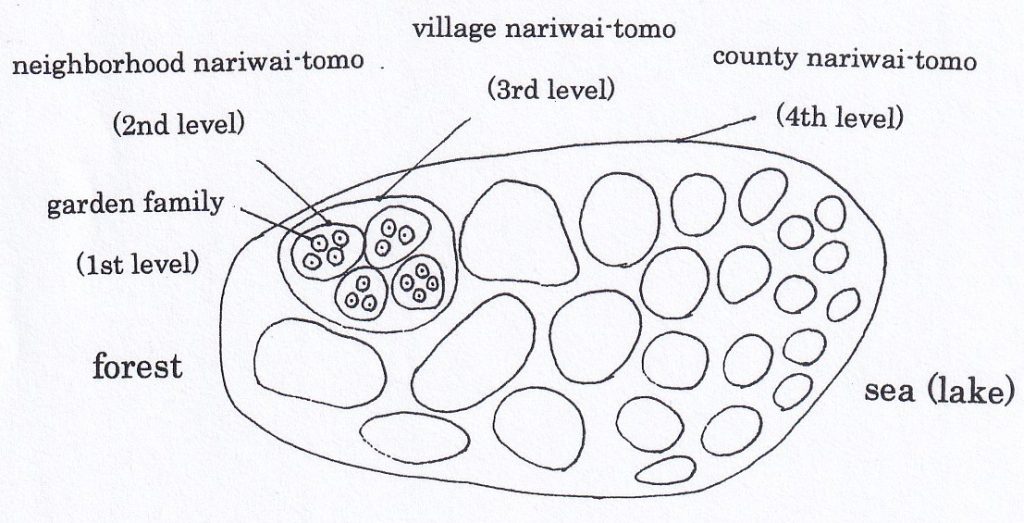
— Multi-layered “Garden Family” Jinen (naturalness) Network —
What is nurtured here are, first and foremost, free individuals with unique personalities, autonomous families with excellent anti-market immunity — in other words, “garden families,” a new form of human social existence in which the personalities of “labor” and “farmer” are integrated and fused together, an autonomous local community with excellent anti-market immunity, and on this foundation are born ideas, culture, and art, as well as performing arts as popular entertainment.
Nowadays, sports have become extremely large-scale and commercialized, and even with online casinos rampant, have been spoiled by capitalism. This is out of the question. We must rebuild the wide variety of sports that should exist as they should be, where individuals get their bodies moving and enjoy themselves independently.
Furthermore, various cultural and artistic movements, free social movements, free and vigorous political activities of various parties, and religious activities of various sects will develop based on these foundations. In other words, they are a totality of truly lively, creative, and free-spirited human activities.
Crops that do not fit into the soil with its aggregate structure that has been lovingly cultivated over many years will not grow and will eventually wither. Ultimately, the fate of all the crops that grow there is determined by the type of social soil that people prepare. From nutritious, fluffy soil, it is inevitable that wonderful, distinctive crops will grow.
With complete confidence in this, the activities of the “Garden Family” Jinen (naturalness) Network are all about this painstaking, grandiose “soil preparation” that is fundamental to the growth of all “crops.” And nothing else.
It goes without saying that we must not overly belittle the role and goals of the activities of local residents and citizens, or narrow them down to the activities of a particular political party or sect, or organizing a particular political party or sect. “Community building” is a much more fundamental, free, and generous human endeavor. Here too, Shoeki Ando’s “philosophy of Jinen (naturalness)” permeates.
Whether it is the shocking decline of the labor union movement in Japan, the decline of local government capabilities, or the flagrantly critical state of “leave it to others democracy” especially at the national level, the underlying cause of all of these is precisely a hopeless passivity that is akin to resignation that has accumulated like sediment in the depths of people’s hearts for a long time, torn away from the fertile land and eroded by the market.
We have forgotten to prepare fertile social “soil” with this aggregate structure of local community, and instead, we are living in an area with single-grained structure, where the “soil” has become barren like sand, composed of the social existence form of the rootless human being known as the wage laborer, who could be said to be the offspring of modernity, as the basic unit.
Especially in developed capitalist economic powerhouses, under the extreme belief that economic growth is the omnipotent force, human desires have expanded without limit, and people have become completely imbued with the narrow values of misers who reduce the meaning of life to money and things. More than ever before, an easygoing, don’t-rock-the-boat mentality has been further nurtured, and the ideological soil for a “leave it to others democracy” has been prepared.
In this way, both people’s bodies and their sense of initiative are eroded in a cruel manner before one realizes it. Now, postwar democracy has regressed to a point where it cannot be fixed if this loss of people’s initiative is allowed to continue, and it is being forced to become a mere formality.
Now that we have marked 80 years since the end of the war, we must first and foremost deeply question the nature of society and devote all our efforts to making a fresh start, in order to cultivate and build a new sense of initiative for ourselves.
We must establish people’s true initiative deep within our own society, not a formal, borrowed democracy based on legal texts, that will not be defeated even in the face of any ferocious reaction. Our future depends on whether we succeed in doing so.
First and foremost, we must start from the fact that, to reiterate, one’s own local “area” and one’s “workplace” (“labor site”) must be thought up and constructed with one’s own hands.
This is an immutable, fundamental principle and belief that people who have lived on the land and are rooted in it for a long time in human history have acquired from simple lives in which mental labor and physical labor were integrated and harmonized, and it is an important principle that we must never forget, even today.
Modern times(capitalism) have easily and in a short time pushed these principles and beliefs into oblivion. There is no way that we should have the condescending Abenomics, a borrowed system given from above that mocks the initiative of the people, or the “regional revitalization” of the Yoshihide SUGA administration that succeeded it, furthermore, the deceptive “digital garden city-state concept” touted by the newly-appointed Fumio KISHIDA administration, which came to power under the banner of a “new capitalism” with a new look, or the deceptive “regional revitalization” of the LDP (the Liberal Democratic Party )’s ISHIBA administration, which, as soon as he became prime minister of a minority ruling party, began to use the phrase “fellow citizens” an eerie amount of times, completely concealing its true nature, and shamelessly watching every opportunity with a vigilant eye to put Japan on the path of a militaristic Japan.
No matter how long it takes, the autonomous “Garden Family” Jinen (naturalness) Network will recapture these fundamental principles and beliefs of human life and take a sure first step toward accomplishing this important 21st century challenge that faces us today.
(7) Reject “leave it to others democracy” and above all, establish our own initiative
— That is where the true joy of living as a human being lies —
As mentioned earlier, Japan’s economy is currently in a long-term crisis in terms of growth and profitability. This long-term stagnation shows that the accumulation structure that has led the postwar economy, which has eliminated excess production capacity that has been formed based on capital investment and the transfer of labor from rural areas to cities through a wasteful lifestyle, “exports,” and “public works,” has reached its limits. We must take this seriously.
While we avoided fundamental reform and sat idly by unable to come up with a policy that would address this structural excess from the ground up, the “lost two decades” that began in the early 1990s have long since passed. During this time, we have been unable to cast off the illusion of “economic recovery” or “another period of high growth,” and have continued to drag on with the same old policies. As a result, the situation has only gotten worse.
What should we really learn from these “lost 20 years”? While we are complacent, saying that the “garden family” vision for a future society is an anachronism, the “lost 30 years” will pass in the blink of an eye. The longer it goes on, the more distant fundamental reconstruction will become, and the more difficult it will become.
The second Abe administration, which began in December 2012, took a highly risky gamble, putting the lives of the people at risk.
The world was suddenly in a euphoric mood as the sudden rise in the value of the yen, stock prices, and bonds strengthened with the surprise of “Abenomics” and Bank of Japan leader Kuroda’s “unconventional monetary easing.” However, this was short-lived, as the COVID-19 pandemic in 2020 caused the postponement of the Tokyo Olympics, and the veneer of this fictitious “economic recovery” mood was quickly peeled away.
The moment of celebration soon came to an end, and the Ukrainian War broke out in February 2022. Life is getting increasingly difficult for the majority of the population, although it may not be the case with the wealthy few.
We need to know that we have reached the limit of what can be called stopgap treatment, which involves sticking on band-aids and putting up safety nets each time we face a never-ending stream of problems while trying to deal with each one.
What is really needed now is not to deal with problems after they have occurred, but to fundamentally change the very nature of society that is the source of the problems. We need to seriously engage in causal treatment that will fundamentally change the nature of today’s extremely weakened society.
It is a process that requires a long-term perspective, with a firm eye on at least 10, 20, 30, or 50 years ahead, to steadily and patiently build up the foundations for reconstruction one step at a time, while fundamentally transforming the very nature of “families” and local “areas,” based on the “garden family,” a form of human social existence with excellent anti-market immunity that integrates and fuses the personalities of “labor” and “farmer,” in order to address the structural contradictions that could be described as inevitable in postwar society.
Due to the ambition of prioritizing economic growth and the sweet words of government scholars and critics, the location of the problem has gradually become obscured and shifted, forcing us to take steps back, but there is something we must keep in mind once again.
According to the IPCC Special Report on Global Warming of 1.5°C (2018), humanity is faced with the heavy task of having to reduce greenhouse gas emissions such as CO2 to virtually zero by 2050, 25 years from now.
Nuclear power was once hyped as a “clean energy source with zero CO2 emissions,” but the Fukushima nuclear accident of March 11, 2011 has made everyone aware of its enormous dangers.
If we are to honestly face up to this enormous problem which could completely negate our very existence, and if we truly wish to find a solution to it, then we must immediately abolish nuclear power plants, and in line with the international goal of reducing CO2 emissions that many people around the world are striving to achieve, we must look 10, 20 or even 30 years into the future and envision and aim to realize the CFP complex society based on the “garden family,” a new form of human social existence with excellent anti-market immunity that integrates and fuses the personalities of “labor” and “farmer.” This will be the decisive key to reducing CO2 emissions and curbing waste of energy and resources. We cannot afford to call this a “dream.”
Rather, it will undoubtedly play an important role in the growing international debate and movement on the issue of phasing out nuclear power and global environmental issues, and will play a leading role in these discussions. Above all, for the sake of our children’s and grandchildren’s future, it is important to paint a picture of what the ideal world should look like, take the first step toward that goal as soon as possible, and make every effort possible.
Building the CFP complex society based on the “garden family” and revitalizing river basin areas connecting the forest and the sea.
This CFP complex society will only be able to take shape and mature in earnest with the birth of truly democratic local governments led by the people who aspire to the ideal of nature’s cycles-based symbiosis, and with a truly democratic government established on this foundation.
It is only under this new government that it will be possible to come up with fundamental and groundbreaking macroeconomic policies, including fiscal, financial and trade policies that are appropriate to the ideal of nature’s cycles-based symbiosis, while fully incorporating objective social and economic changes and the realities of the time.
Only then will it be possible to fully develop and implement comprehensive and concrete policies for the “family,” the fundamental community in our social structure, and the “local community,” which is its aggregate, as well as for society, education, culture, and more.
As a result, a high-level social security system for child-rearing, medical care, nursing care, pensions, and other areas full of human warmth and appropriate for a new era will be established that organically combines public functions with the gradually revitalized capabilities of the “family” and “local community” under a new tax and fiscal system that places people first.
The CSSK mechanism proposed in Chapter 10 of the main text of the long-running series, the “Organization for Promoting the Reduction of CO2 and the Creation of Garden Families” (the abbreviation: CSSK, taking the initials of the Japanese name), will likely begin to operate, albeit imperfectly, at the prefectural level, even from the initial stage, which could be called the “infancy stage” prior to the “full-scale formation stage” of the CFP complex society. This will also mean steadily building the foundation that will promote the transition to the “full-scale formation stage” of the CFP complex society on a national scale, starting from local “areas.”
And once a new grassroots, people-led government is established that aspires to become a mature, advanced welfare nation built on the ideal of nature’s cycles-based symbiosis, that is, on the foundation of “garden families,” then the CSSK mechanism will grow into a fully-fledged system with functions at the national level, and together with the new government’s “full-scale implementation of comprehensive and concrete policies,” it will undoubtedly play an even more important role and demonstrate exceptional effectiveness.
(8) The “future of the 21st century” becomes clear through the continuous spiral movement of “checking, research, and planning” for one’s own home area
Although we have spent so much time up until now, we are finally standing at the entrance to the “infancy stage” of the CFP complex society based on the “garden family.” Where should we start?
This may seem trite and tedious, but based on the ideas and methods of “area ecology” as an innovative area studies that is naturally derived from the universal principle of “adaptation and adjustment” (= “self-organization”) of formation and evolution that permeates both the natural world and human society, surely it is important to start by selecting a specific “river basin area that connects the forest and the sea” model in one’s own home area, and then thinking about it concretely as an issue that is close to you.
In order to clarify the future vision that the local “area” should aim for, residents and citizens of all generations, including children, young people, and the elderly, will need to join in the continuous spiral movement of “recognition and practice” of “checking, research, and planning” for their home area, and work tenaciously for themselves.
What is important in this case is to first boldly sketch out a future vision of one’s home area, even if it is incomplete, as a working hypothesis for the initial stage of this continuous spiral movement, based as much as possible on the realities of the local “area,” without being swayed by the “common sense” of the world.
By repeatedly setting such hypotheses and then conducting research and verification, the true nature of one’s own local “area” will become clear for the first time. From there, a more concrete vision of the future that one’s own local “area” and Japan should aim for will also emerge.
Shortly after the war, the historian Tadashi ISHIMODA, known for his classic work “The Formation of the Medieval World” (1946), confronted the history that was imposed on us from above, saying, “Wherever there are people, wherever there is life, there is a rich history,” and that such history “must be written by the people themselves” (‘Village History, Factory History,’ Rekishi Hyoron 3-1, 1948). This prompted a movement for “historical studies for the people,” which led to the formation of individuals that would shoulder the responsibility of postwar democracy through digging up and learning together about the history of people’s own “villages” and “factories.”
The very spirit embedded in this must be the most important thing that we must bring back to our grassroots, national movements, which have become so shriveled in modern times.
The never-ending spiral circular movement of “recognition and practice” of “checking, research, and planning” that confronts today’s reality and paints a vision for the future of one’s home area is reminiscent of the former “historical studies for the people” movement, and can be seen as the proposal for a new movement for the 21st century that could be called a “future area studies by the people, for the people” movement.
The previously proposed “Jinen (naturalness) Forum to Consider the Future of Our Country and Local Area in the 21st Century” (tentative name) should be the first step in launching this national movement in each of our local “areas,” and should serve as the parent organization.
Without this kind of grassroots, steady activity that strives toward clear goals for the future, it is safe to say that there is no way to achieve independence of local “area” and pave the way for the future in the face of the expansionism by a handful of politicians, huge financial capital, and global multinational corporations.
This may seem like a roundabout way of doing things, but wouldn’t this the real, practical shortcut we can take?
This means eliminating the deceptive social habit of “leave it to others democracy” that has been reduced to short-term “elections” and has clung to us like sediment, and instead aiming for the magnificent future society of the 21st century, establishing our own initiative from our own feet, with our own hands. We are eagerly awaiting this kind of comprehensive, autonomous national movement that is deeply rooted in the lives of the people.
It is in this kind of steady, creative practice that we find the true joy of living, something that humans cannot replace with anything else.
Wandering through the sea of suffering,
my tipsy dreams
paint a picture of tomorrow on Mother Earth
We must break the cycle of inequality and injustice, division and conflict, and create a new world filled with the scent of the earth and the colors of nature, where humanity is rich in life and where all lives shine.
The path to becoming a mature, advanced welfare nation that has overcome modernity, built on the foundation of the “garden family,” a form of human social existence that integrates and fuses modern and pre-modern “labor” and “farmer” personalities with excellent anti-market immunity, is by no means an empty dream.
The “Garden Family” vision for a future society as a way to realize a “future society theory based on living systems,” which is currently often thought of as impossible, will surely become more likely to be realized through the heartfelt wishes of many people and an accumulation of many years of trial and error by people in a variety of “communities.”
We believe that this long and arduous process is the only way left to realize the essence of the spirit embedded in the Constitution of Japan.
In the eternal time and space,
we are all born into Mother Earth,
nurtured by Mother Earth,
and to Mother Earth we will return.
――― ◇ ◇ ―――
With Assistance from
LIFE-ON Co., Ltd. (Representative: Satoshi KUSAKA)
September 28, 2025
Satoyama Research Cottage Nomad
Masao ONUKI & Keiko ITO
Satoyama Research Cottage Nomad
452 Ojigahata, Taga-cho, Inukami-gun, Shiga Prefecture, 522-0321 JAPAN
TEL&FAX:0749-47-1920
E-mail:onuki☆satoken-nomad.com
(Please replace ☆ with @ when sending email.)
URL. https://www.satoken-nomad.com/
